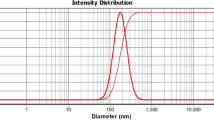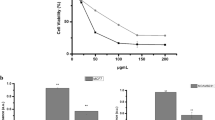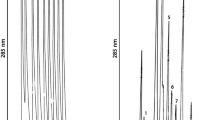Abstract
In this study, we investigate the possible cytotoxic effects of different Nigella sativa seed extracts on human MCF-7 breast cancer cells and screening the effects of a wide range of extracts concentrations and their application as an adjuvant therapy to doxorubicin. The results obtained showed that the cytotoxic solvent dimethyl sulfoxide can be used for permeation assay in concentration range 697.5–0.341 mmol/ml without affecting the viability of MCF-7 cells. N. sativa lipid extract is cytotoxic to MCF-7 cells with LC50 of 2.72 ± 0.232 mg/ml, while its aqueous extract cytotoxicity exhibited when the applied concentration is high as ≈ 50 mg/ml. The results of this study reveal for the first time that low concentrations of aqueous extract of the seed has a hormetic rather than cytotoxic effect. It is also possible to use cell culture medium or bovine serum to dilute the oil extract for the permeation assay. In conclusion, N. sativa aqueous extract should not be used as antitumor compound by its own. The oil is a promising antitumor compound and its cytotoxicity was greatly enhanced with its nanoemulsion formulation. Antitumor activity of doxorubicin was enhanced, as a function of time, when N. sativa extracts were involved as adjunct therapeutic compounds. Adding doxorubicin to the prepared lipid nanoemulsion has a beneficial impact to their bioactivity. These doxorubicin—N. sativa lipid nanoemulsion are promising and potential therapeutic modality.








Similar content being viewed by others
References
Cui, J. L., Guo, S. X., & Xiao, P. G. (2011). Antitumor and antimicrobial activities of endophytic fungi from medicinal parts of Aquilaria sinensis. Journal of Zhejiang University Science B, 12, 385–392.
Goreja, W. G. (2003). Black seed: Nature’s miracle remedy. New York: Amazing Herbs Press.
Abdel-Aal, E. S. M., & Attia, R. S. (1993). Characterization of black cumin (Nigella sativa) seeds. 2-proteins. Alexandria Science Exchange Journal, 14, 483–496.
Haq, A., Remo, N., & Al-Sedairy, S. T. (1996). Fractionation of black seed (Nigella sativa Linn.) proteins by using rotofor. Journal of Liquid Chromatography and Related Technologies, 19, 593–599.
Takruri, H. M. H., & Dameh, M. A. F. (1998). Study of the nutritional value of black cumin seeds (Nigella sativa L.). Journal of the Science of Food and Agriculture, 76, 404–410.
Salem, M. A. (2001). Effect of some heat treatment on Nigella seeds characteristic–some physical and chemical properties of Nigella seed oil. Journal of Agricultural Research, 27, 471–486.
Ramadan, M. F., & Moersel, J. T. (2002). Neutral lipid classes of black cumin (Nigella sativa L) seed oils. European Food Research and Technology, 214, 202–206.
Duke, J. A. (1992). Handbook of phytochemical constituents of GRAS herbs and other economic plants (pp. 35–69). Florida: CRC Press.
Al-Gaby, A. M. (1998). Amino acid composition and biological effects of supplementing broad bean and corn proteins with Nigella sativa (Black cumin) cake protein. Nahrung, 42, 290–294.
Burits, M., & Bucar, F. (2000). Antioxidant activity of Nigella sativa essential oil. Phytotherapy Research, 14, 323–328.
Mansour, M. A., Nagi, M. N., El-Khatib, A. S., & Al-Bekairi, A. M. (2002). Effects of thymoquinone on antioxidant enzyme activities, lipid peroxidation and DT-diaphorase in different tissues of mice: a possible mechanism of action. Cell Biochemistry and Function, 20, 143–151.
Mahgoub, A. A. (2003). Thymoquinone protects against experimental colitis in rats. Toxicology Letters, 143, 133–143.
Khan, M. T. H., Jabbar, S., Choudhuri, M. S. K., & Ghafur, M. A. (1999). Analgesic and antiinflammatory activity of Nigella Sativa Linn. Hamdard Medicus, 42, 22–29.
Al-Ghamdi, M. S. (2001). The anti-inflammatory, analgesic and antipyretic activity of Nigella sativa. Journal of Ethnopharmacology, 76, 45–48.
Sokmen, A., Jones, B. M., & Erturk, M. (1999). The in vitro antibacterial activity of Turkish medicinal plants. Journal of Ethnopharmacology, 67, 79–86.
Aboul-Ela, E. I. (2002). Cytogenetic studies on Nigella sativa seeds extract and thymoquinone on mouse cells infected with schistosomiasis using karyotyping. Mutation Research, 516, 11–17.
Singh, G., Marimuthu, Pa, Heluani, C. S., & Catalan, C. (2005). Chemical constituents and antimicrobial and antioxidant potentials of essential oil and acetone extract of Nigella Sativa seeds. Journal of the Science of Food and Agriculture, 85, 2297–2306.
Akhtar, A. H., Ahmad, K. D., Gilani, S. N., & Nazir, A. (1996). Antiulcer effect of aqueous extracts of Nigella sativa and Pongamia pinnata in rats. Fitoterapia, 67, 195–199.
Rajkapoor, B., Anandan, R., & Jayakar, B. (2002). Anti-ulcer effect of Nigella Sativa Linn. against gastric ulcers in rats. Current Science, 82, 177–185.
Janbaz, K. H., Saeed, S. A., & Gilani, A. H. (2003). Hepatoprotective effect of thymol on chemical induced hepatoprotectivity in rodents. Pakistan Journal of Biological Sciences, 6, 448–451.
Gilani, A. H., Shaheen, F., & Shakir, T. (2001). Thymol lowers blood pressure through blockade of calcium channels. Fundamental & Clinical Pharmacology, 15, 163.
Bamosa, A. O., Ali, B. A., & Al-Hawsawi, Z. A. (2002). The effect of thymoquinone on blood lipids in rats. Indian Journal of Physiology and Pharmacology, 46, 195–201.
Zaoui, A., Cherrah, Y., Mahassine, N., Alaoui, K., Amarouch, H., & Hassar, M. (2002). Acute and chronic toxicity of Nigella Sativa fixed oil. Phytomedicine, 9, 69–74.
Mabrouk, G. M., Moselhy, S. S., Zohny, S. F., et al. (2002). Inhibition of methylnitrosourea (MNU)-induced oxidative stress and carcinogenesis by orally administered bee honey and Nigella grains in Sprague Dawely rats. Journal of Experimental & Clinical Cancer Research, 21, 341–346.
Salomi, M. J., Nair, S. C., & Panikkar, K. R. (1991). Inhibitory effects of Nigella Sativa and saffron (Crocus Sativus) on chemical carcinogenesis in mice. Nutrition and Cancer, 16, 67–72.
Salomi, M., Panikar, J. K. R., Kesvan, M., Donata, S., & Rajagopalan, K. (1989). Anticancer activity of Nigella Sativa. Ancient Science of Life Journal, 8, 262–266.
Medenica, R., Janssens, J., Tarasenko, A., et al. (1997). Anti-angiogenic activity of Nigella Sativa plant extract in cancer therapy. Proceedings of the Annual Meeting of the American Association for. Cancer Research, 38, A1377.
Swamy, S. M. K., & Tan, B. K. H. (2000). Cytotoxic and immunopotentiating effects of ethanolic extract of Nigella Sativa seeds. Journal of Ethnopharmacology, 70, 1–7.
Farah, I. O. (2005). Assessment of cellular responses to oxidative stress using MCF-7 Breast cancer cells, black seed (N. Sativa L.) extracts and H2O2. International Journal of Environmental Research and Public Health, 2, 411–419.
Abuharfeil, N. M., Salim, M., & Kleist, S. V. (2001). Augmentation of natural killer cell activity in vivo against tumor cells by some wild plants from Jordan. Phytotherapy Research, 15, 109–113.
Woo, C. C., Loo, S. Y., Gee, V., Yap, C. W., Sethi, G., Kumar, A. P., et al. (2011). Anticancer activity of thymoquinone in breast cancer cells: Possible involvement of PPAR-γ pathway. Biochemical Pharmacology, 82, 464–475.
Atta, M. B. (2003). Some characteristics of nigella (Nigella sativa L.) seed cultivated in Egypt and its lipid profile. Food Chemistry, 83, 63–68.
Khan, M. A. U., Ashfaq, M. K., Zuberi, H. S., Mahmood, M. S., & Gilani, A. H. (2003). The in vivo antifungal activity of the aqueous extract from Nigella sativa seeds. Phytotherapy Research, 17, 183–186.
Demel, R. A., Van Deenen, L. L. M., & Pethica, B. A. (1967). Monolayer interactions of phospholipids and cholesterol. Biochimica et Biophysica Acta Impact Factor, 135, 11–19.
Cannon, B., Lewis, A., Somerharju, P., Virtanen, J., Huang, J., & Cheng, K. H. (2010). Acyl-chain mismatch driven superlattice arrangements in DPPC/DLPC/cholesterol bilayers. The Journal of Physical Chemistry B, 114, 10105–10113.
Bristow, M. R., Billingham, M. E., Mason, J. W., & Daniels, J. R. (1978). Clinical spectrum of anthracycline cardiotoxicity. Cancer Treatment Reports, 62, 873–879.
Author information
Authors and Affiliations
Corresponding author
Rights and permissions
About this article
Cite this article
Mahmoud, S.S., Torchilin, V.P. Hormetic/Cytotoxic Effects of Nigella sativa Seed Alcoholic and Aqueous Extracts on MCF-7 Breast Cancer Cells Alone or in Combination with Doxorubicin. Cell Biochem Biophys 66, 451–460 (2013). https://doi.org/10.1007/s12013-012-9493-4
Published:
Issue Date:
DOI: https://doi.org/10.1007/s12013-012-9493-4




